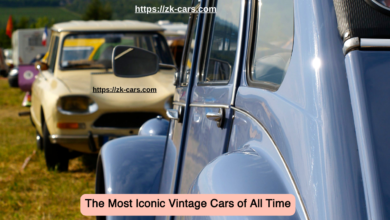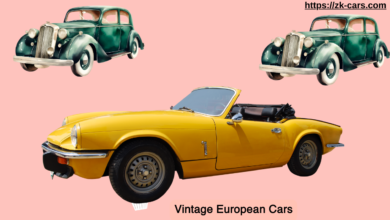
Vintage car clubs have always been at the heart of automotive culture, uniting enthusiasts passionate about preserving automotive history. However, with the rise of digital platforms and shifting generational interests, the landscape for vintage car clubs is changing. As we move forward, these communities face challenges but also new opportunities to grow and evolve. This article explores the future of vintage car clubs, highlighting the trends, technological advancements, and strategies shaping their path ahead.
1. The Evolution of Vintage Car Communities
Vintage car clubs have transitioned from traditional, local meetups to hybrid spaces that blend in-person events with online communities. In the past, enthusiasts mainly interacted through local gatherings, magazines, and car shows. Today, the rise of social media platforms such as Instagram, Facebook, and YouTube has enabled car lovers to connect globally.
- Exclusive Online Groups: Many clubs now run digital forums and private groups to engage members.
- Virtual Events: Online car shows and virtual meetups attract participants who cannot attend physical events.
- Digitized Archives: Vintage clubs increasingly upload manuals, rare photographs, and car restoration tips to online libraries.
The shift to a digital environment fosters deeper engagement, but it also raises questions about the essence of these clubs and how they retain their authentic community spirit.
2. Modernizing Membership Models for Future Growth
Attracting new members, particularly younger enthusiasts, has become a top priority for vintage car clubs. While older generations may appreciate the nostalgia of 20th-century models, younger audiences gravitate towards customization trends and digital engagement.
Key Changes in Membership Models:
- Flexible Membership Tiers: Clubs are moving away from rigid annual fees to offer monthly or event-based memberships.
- Digital-Only Memberships: Some clubs introduce low-cost options for members who prefer virtual interaction over in-person meetups.
- Youth-Focused Programs: Clubs are creating initiatives to attract younger audiences, such as mentorship programs in restoration and maintenance.
By catering to the preferences of diverse age groups, vintage car communities can remain relevant and future-proof their existence.
3. Technology’s Role in Preserving Vintage Cars
Technology has been a driving force behind the preservation and revival of vintage cars. Advances in 3D printing and electric vehicle (EV) conversions open exciting possibilities for car enthusiasts.
- 3D Printing Parts: Rare components that are no longer produced can now be recreated using 3D printing technology, ensuring vintage cars stay operational.
- Electric Conversions: While purists may resist the idea of electrifying classic cars, EV retrofits are gaining popularity, especially among younger enthusiasts focused on sustainability.
- Restoration Software: Digital tools assist in tracking parts, recording maintenance history, and providing step-by-step guides for rebuilding engines and interiors.
These technological advancements allow vintage car owners to extend the lifespan of their vehicles while adapting to modern standards.
4. Sustainability and the Shift to Electric Vintage Cars
Environmental concerns are influencing the car community, including vintage enthusiasts. Governments worldwide are tightening emission regulations, creating challenges for vintage cars that run on outdated engines. However, this also introduces an opportunity for clubs to explore sustainable alternatives.
- Eco-Friendly Restorations: Vintage enthusiasts are experimenting with biofuels and more environmentally friendly materials during restoration.
- Electric Swaps: Converting classic cars into electric vehicles makes them compliant with modern emissions laws while retaining their iconic design.
While some traditionalists resist these changes, clubs that embrace sustainability can broaden their appeal and align with future automotive trends.
5. Expanding Community Engagement through Events and Partnerships
Events are a cornerstone of vintage car clubs, but to remain relevant, clubs must diversify their offerings beyond traditional car shows and rallies.
Emerging Event Trends:
- Collaborations with Automakers: Clubs are forming partnerships with car manufacturers to showcase restored vehicles at official launches.
- Lifestyle Events: Vintage clubs are integrating car culture with music festivals, food events, and travel experiences.
- Road Trips and Scenic Drives: Organizing group drives across scenic routes fosters camaraderie and enhances the community’s sense of belonging.
By evolving their event offerings, clubs attract new members and build stronger connections with existing ones.
6. The Role of Social Media in Promoting Vintage Car Clubs
The importance of a strong online presence cannot be overstated in today’s digital era. Vintage car communities use social media platforms to document journeys, share restoration projects, and organize events.
- Instagram: Enthusiasts share high-quality photos and videos, providing visual storytelling that captures the essence of vintage cars.
- Facebook Groups: Many clubs maintain active discussion groups on Facebook to facilitate communication among members.
- YouTube Channels: Video content, including car reviews and restoration tutorials, helps clubs reach broader audiences.
An effective digital strategy ensures vintage car clubs stay visible and engage with both current and potential members.
7. Challenges Ahead: Keeping Tradition Alive in a Modern World
While embracing change is crucial, vintage car clubs must remain true to their roots. As clubs adopt new technologies and sustainability practices, they face the challenge of retaining the essence of vintage car culture.
Some key challenges include:
- Balancing Tradition with Innovation: Clubs must find the right balance between honoring the history of vintage cars and embracing modern trends.
- Aging Membership: Many clubs have a significant proportion of older members, making it essential to attract younger participants to secure the club’s future.
- Regulatory Issues: Stricter emission standards may impact the use of older vehicles, requiring innovative solutions such as special permits or exemptions.
Navigating these challenges will be critical for vintage car communities as they move forward.
Conclusion: A Bright Future for Vintage Car Clubs
Vintage car clubs and communities are undergoing significant transformations to adapt to modern times. From embracing new technologies to exploring sustainable restoration practices, these clubs are evolving while keeping the passion for vintage cars alive. With a combination of innovative event planning, social media engagement, and flexible membership models, the future looks promising. However, maintaining the balance between tradition and innovation will be crucial for long-term success.
Vintage car clubs must remain resilient in the face of challenges, fostering community spirit while staying relevant to future generations. With the right strategies, these communities will thrive and ensure that the legacy of vintage cars endures.
Frequently Asked Questions about the Future of Vintage Car Clubs
- What are some ways vintage car clubs attract younger members?
- Clubs use youth programs, digital memberships, and social media to engage with younger audiences.
- How do electric vehicle conversions affect vintage cars?
- EV conversions make vintage cars compliant with modern emissions laws and extend their usability.
- What role does social media play in vintage car communities?
- Social media platforms help clubs document journeys, organize events, and engage members.
- Are there sustainable practices for restoring vintage cars?
- Yes, many enthusiasts use biofuels, eco-friendly materials, and electric retrofits during restorations.
- What are some challenges vintage car clubs face today?
- Aging membership, regulatory restrictions, and balancing tradition with innovation are key challenges.




